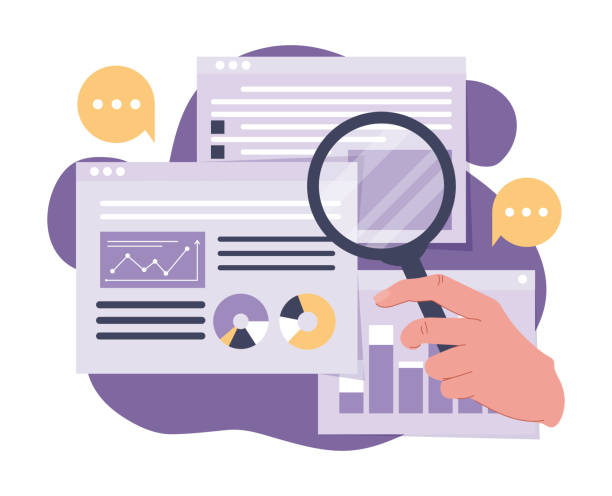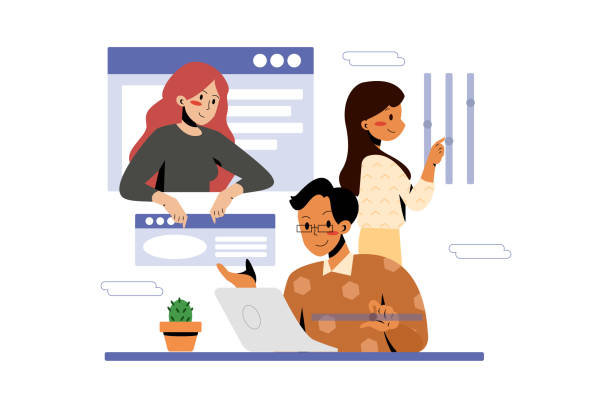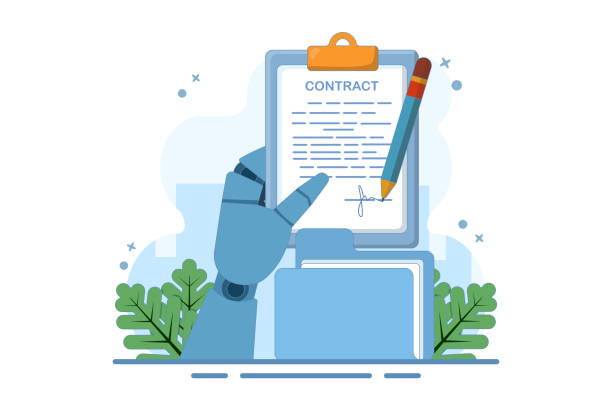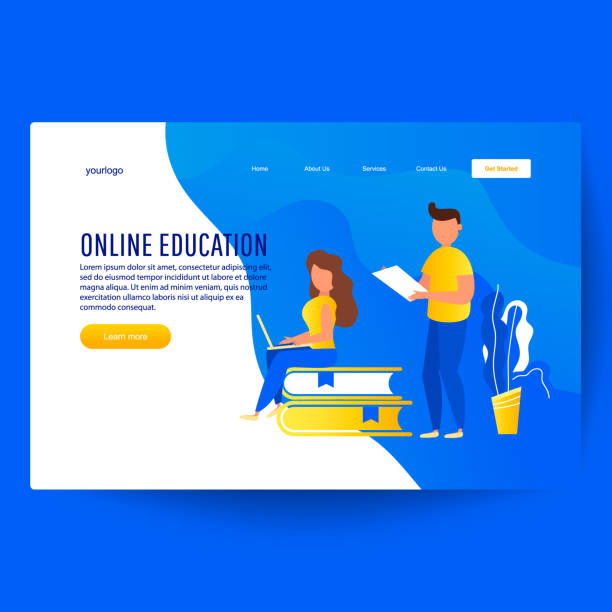The Importance of Modern UI Website Design in the Digital Age

In today’s world, where online competition has reached its peak, having a website is not merely about having an online presence; rather, this presence must be meaningful and impactful.
The User Interface (UI) of a website is the first point of contact between users and your brand or business.
The question is, has your website managed to captivate and convince the user to stay on your pages at first glance? This is where the importance of #Modern_UI_Website_Design and #User_Experience (UX) becomes clearly evident.
An outdated and complex design can easily drive visitors away, even if your content is highly valuable.
Conversely, a modern and user-friendly design not only increases user retention time on the site but also significantly contributes to improving conversion rates and ultimately the success of your business.
Today, users expect websites to be not only beautiful but also fast, functional, and accessible from any device.
This perspective has completely transformed our approach to modern UI website design.
Successful websites are those that not only meet user needs but also exceed their expectations, creating a memorable experience.
Ignoring this vital aspect means missing out on countless opportunities in the digital market.
Are you ready to turn your website into a powerful tool for attracting and retaining customers?
Are you dissatisfied with the low conversion rate of visitors to customers on your e-commerce site?
Solve this problem permanently with professional e-commerce website design by Rasaweb!
✅ Increase visitor-to-customer conversion rate
✅ Create an excellent user experience and build customer trust
⚡ Get free consultation
Fundamental Principles of Modern User Interface and User Experience

To achieve a modern UI website design, we must have a deep understanding of the fundamental principles of UI and UX.
The core of any successful design is a user-centered approach.
This means placing users’ needs, goals, and behaviors at the center of the design process.
Usability is one of the most important of these principles; it means that users should be able to interact with your site easily and without confusion and achieve their goals.
Accessibility is also of paramount importance, ensuring that your website is usable by everyone, including people with disabilities.
Consistency in the design of elements, colors, and fonts throughout the site creates a sense of familiarity and comfort for the user and prevents confusion.
Visual Feedback shows users whether their operations were successful or require attention.
For example, changing the color of a button after a click.
Minimalism and Simplicity in design, by removing extraneous elements and focusing on the main content, helps the user concentrate on what is important and provides a more pleasant visual experience.
These principles form the backbone of any successful user interface design, and adhering to them is crucial for creating an unparalleled user experience.
A deep understanding of these specialized concepts is the first step on the path to creating a truly outstanding website.
Practical Solutions for Advanced User Experience Design

To implement a modern UI website design, we need practical, step-by-step solutions.
The first step is to conduct comprehensive research on target users.
A precise understanding of your audience, including their needs, preferences, and challenges, is the foundation of any successful design.
Creating user personas and scenarios helps you empathize with your users and shape the design based on their real needs.
Using wireframes and prototypes in the early stages of design allows for testing and validating ideas before coding, preventing wasted time and cost.
Emphasis on Responsive Design is a necessity to ensure the website displays correctly on all types of devices, from desktops to mobiles and tablets.
Furthermore, optimizing page load speed is critically important, as today’s users have little patience.
For this purpose, image optimization, code compression, and the use of Content Delivery Networks (CDNs) can be utilized.
Finally, attention to small details such as subtle animations, microinteractions, and appropriate typography can significantly impact the overall user experience.
Here is a summary of some key principles in UI design:
| Principle | Description |
|---|---|
| User-Centricity | Always prioritize user needs and expectations. |
| Simplicity and Clarity | Convey the message clearly and unambiguously; avoid complexity. |
| Consistency and Uniformity | Use consistent design elements throughout the website. |
| Immediate Feedback | Provide appropriate reactions to user actions. |
| Accessibility | The website should be usable by all users, including those with disabilities. |
The Impact of Responsive User Interfaces on SEO and Website Performance

In today’s world, it is no longer sufficient to design a website solely for desktop display.
With the ever-increasing use of mobile phones and tablets for internet access, Responsive Design has become an undeniable necessity in modern UI website design.
A responsive website automatically adjusts its layout and content to the user’s screen size, providing a seamless and optimized experience on any device.
This is not only crucial for user satisfaction but also has a direct impact on SEO and your website’s ranking in search engines like Google.
Google has officially stated that it prioritizes mobile-friendly websites in its search results.
Therefore, if your website is not optimized for mobile, it may achieve a lower ranking in competition with responsive sites.
In addition to SEO, responsive design helps increase conversion rates and reduce bounce rates.
A user who encounters a non-responsive and unreadable website on their mobile device will quickly leave it.
This rapid exit increases your website’s bounce rate, which can send a negative signal to search engines.
Consequently, investing in responsive UI design is not just a choice but a requirement for online success and an integral part of any modern web design strategy.
Does your current website convert visitors into customers, or does it drive them away? Solve this problem permanently with professional corporate website design by Rasaweb!
✅ Build credibility and powerful branding
✅ Attract target customers and increase sales
⚡ Get free consultation now!
Psychology of Color and Form in Creative User Interface Design

One of the fascinating yet complex aspects of modern UI website design is the utilization of color and form psychology.
Colors and shapes, beyond their visual appeal, are capable of influencing users’ emotions, behaviors, and even decision-making.
Choosing an appropriate color palette can strengthen brand recognition and convey a subconscious message to the audience.
For example, blue typically evokes a sense of trust and professionalism, while red can suggest excitement and urgency.
Understanding the impact of each color and intelligently using them in key elements such as Call-to-Action (CTA) buttons, headers, and backgrounds can help improve user experience and increase engagement.
Forms and shapes also play a significant role.
Using rounder and softer shapes can convey a sense of friendliness and accessibility, while sharp and angular shapes might evoke power or technology.
Creating a visual hierarchy by utilizing differences in size, color, contrast, and white space helps users easily identify the most important information and guides their eye movement across the page.
An intelligent design is not only beautiful but also built on psychological principles, subconsciously guiding users towards desired goals.
This blend of art and science transforms modern UI website design into a truly engaging and creative field that pushes the boundaries of visual communication.
New Tools and Techniques for Modern Web Development

The field of modern UI website design is constantly evolving, with new tools and techniques emerging to streamline the process and improve final quality.
Today’s designers use powerful software like Adobe XD, Figma, and Sketch for design and prototyping.
These tools facilitate collaborative design, creation of interactive prototypes, and user testing with greater ease.
In development, the use of modern JavaScript frameworks such as React, Angular, and Vue.js allows developers to build complex and dynamic user interfaces with high efficiency and easier maintainability.
These frameworks, with their component-based approach, enable faster development and more optimized coding.
For styling and layout, using CSS Frameworks like Bootstrap or Tailwind CSS accelerates the responsive design process and ensures that the website displays correctly across different browsers and devices.
Performance optimization techniques such as Lazy Loading for images and videos, Code Splitting, and the use of Service Workers to enable Progressive Web Apps (PWA) are also becoming standard in modern web development.
These tools and techniques not only help designers and developers deliver higher quality products faster but also raise the level of expectations for modern UI website design, and this is a very important educational point.
Challenges and Solutions for Advanced User Interface Implementation

Implementing a modern UI website design, despite its many advantages, also comes with challenges, and understanding and managing them is essential for success.
One of the biggest challenges is maintaining a balance between visual aesthetics and technical performance.
Sometimes, very beautiful designs can be technically complex, leading to slow website performance or increased development costs.
The solution is for designers and developers to work together from the outset to ensure that designs are both appealing and implementable.
Another challenge is ensuring browser compatibility.
The website must display correctly in various browsers (such as Chrome, Firefox, Safari, and Edge).
Using standard frameworks and libraries and conducting comprehensive tests across different browsers solves this issue.
Managing user expectations is also a significant challenge; given the rapid pace of change in the digital world, users always expect the latest and best experience.
To address this challenge, continuous website updates and attention to user feedback are crucial.
Data security and privacy issues must also be considered in the process of modern UI website design to maintain user trust.
These challenges are opportunities for innovation and finding creative solutions.
Here is a list of commonly used tools in modern UI/UX design and development:
| Category | Tool | Primary Use |
|---|---|---|
| UI/UX Design | Figma | UI design, prototyping, team collaboration |
| UI/UX Design | Adobe XD | Web and app design, wireframing, prototyping |
| UI/UX Design | Sketch | UI design (macOS only) |
| Frontend Development | React.js | Building interactive component-based user interfaces |
| Frontend Development | Vue.js | Progressive framework for building user interfaces |
| Design Systems | Storybook | Documenting and developing UI components |
The Future of Modern UI Website Design

The future of modern UI website design is full of exciting potential and developments.
With technological advancements, the boundaries of what is possible in UI design are constantly expanding.
Artificial Intelligence (AI) and Machine Learning will play an increasingly significant role in personalizing the user experience.
Websites will be able to dynamically adjust content and layout for each individual by analyzing user behavior, providing a truly unique experience.
Virtual Reality (VR) and Augmented Reality (AR) are also entering the web domain, providing platforms for three-dimensional and immersive interactions.
These technologies create new opportunities for creating fully immersive user interfaces that draw users into the virtual world of websites.
Voice User Interfaces (VUI), such as voice assistants, are changing how we interact with devices and websites.
Soon, many web searches and interactions will be conducted via voice commands, creating a need for a deep understanding of natural language and conversational flow design.
No-Code and Low-Code design also enable non-technical individuals to build complex websites with beautiful user interfaces without the need for deep programming knowledge.
This trend accelerates the democratization of web design.
All of this indicates that modern UI website design will transcend a mere technical aspect, evolving into an interactive art that pushes the boundaries of communication between humans and technology.
Are you ready for this exciting future?
Are you dissatisfied with your e-commerce site’s low sales?
Rasaweb is your solution for having a professional and high-selling e-commerce site.
✅ Significant increase in sales and revenue
✅ Easy and enjoyable shopping experience for customers
⚡ Get free consultation from Rasaweb now!
The Role of User Testing and Feedback in UI Optimization

After implementing a modern UI website design, the work does not end.
In fact, this is where the critical phase of user testing and feedback collection begins.
User Testing is one of the most effective methods for identifying the strengths and weaknesses of your user interface.
By observing real users interacting with the website, you can discover problems you never anticipated during the design phase.
These tests can be conducted in person, remotely, with or without a moderator, and provide valuable information about usability, efficiency, and overall user satisfaction.
In addition to targeted tests, continuous feedback collection through survey forms, comment sections, and analysis of user behavioral data with tools like Google Analytics or Hotjar is also very important.
This data helps you understand user behavior patterns, identify pages with high bounce rates, and improve conversion funnels.
Iterative Improvement based on received feedback is the key to UI optimization.
A successful website design is not a static process, but a dynamic and evolutionary path.
With each cycle of testing and feedback, you can refine your design and adapt it to meet the changing needs of users.
This specialized approach ensures that your website remains relevant and effective.
Case Study of Successful Websites with Unparalleled UX/UI

To better understand the concept of modern UI website design, looking at successful examples can be very inspiring.
Sites like Apple and Google are prime examples of minimal and functional design that focus on clarity and ease of use.
Apple’s product pages, using ample white space, high-quality images, and minimal text, guide users towards a visual experience.
Google, with its simple yet powerful user interface, has transformed search into an instantaneous process.
Streaming services like Netflix are also pioneers in their modern UI design and user experience.
With content personalization algorithms, intuitive user interfaces, and powerful search capabilities, they guide users most effectively through an ocean of content.
Each of these examples offers valuable lessons on the importance of user understanding, simplicity in interaction, and functional aesthetics.
They demonstrate how a modern UI website design can become a competitive advantage.
These websites not only have an appealing appearance but also offer flawless and effortless functionality that keeps users satisfied and loyal.
This approach transforms modern UI website design from merely a beautiful design into a powerful tool for growth and innovation.
In summary, the secret to success lies in creating an unparalleled user experience that anticipates and meets user needs in every aspect.
Frequently Asked Questions
| Question | Answer |
|---|---|
| What is a modern user interface? | A modern user interface refers to a design that utilizes new trends, simplicity, excellent user experience, and attractive visual elements. |
| Why is using a modern user interface important in website design? | It leads to attracting and retaining more users, creating a professional impression, improving user experience, and increasing conversion rates. |
| What are the main features of a modern user interface? | Simplicity, sufficient white space, readable typography, attractive and harmonious colors, subtle animations, and responsive design. |
| How is responsiveness related to a modern user interface? | Responsive design is an essential feature in modern UI that ensures the site displays well on all devices (mobile, tablet, desktop). |
| What is the role of typography in modern UI design? | Choosing appropriate fonts and using them correctly increases readability and contributes to the site’s aesthetics and visual identity. |
| What is White Space and why is it important in modern UI? | It is the empty space between different elements on a page, which helps improve readability, user focus, and creates a sense of cleanliness and order. |
| What are the benefits of using animations in modern UI design? | Subtle and purposeful animations can capture user attention, improve interaction, and make information transfer more engaging. |
| How can User Experience (UX) be improved alongside a modern user interface? | By understanding user needs, simplifying navigation paths, providing appropriate visual feedback, and ensuring easy testability. |
| Does a modern user interface always mean using bright colors? | No, a modern user interface can use diverse color palettes, including dark colors; the key is choosing harmonious and brand-appropriate colors. |
| What are the current trends in modern UI design? | The use of Dark Mode, Neumorphism, Glassmorphism, scroll-based animations, and minimalist design. |
And other services of Rasaweb Advertising Agency in the field of advertising
Smart Conversion Rate Optimization: A creative platform for improving campaign management with Google Ads management.
Smart SEO: A specialized service for campaign management growth based on real data.
Smart Social Media: A fast and efficient solution for campaign management focusing on user experience customization.
Smart Marketplace: A professional solution for improving SEO ranking with a focus on user experience customization.
Smart Direct Marketing: An effective tool for attracting customers with the help of attractive UI design.
And over hundreds of other services in the field of internet advertising, advertising consultation, and organizational solutions
Internet Advertising | Advertising Strategy | Advertorial
Resources
History of Web DesignPrinciples of Successful User Interface (UI) DesignWhat is User Experience (UX) and Why is it Vital for Your Site?Website Design Trends in 2023
🌐 For the sustainable growth of your business in the digital world, Rasaweb Afarin Digital Marketing Agency, with its comprehensive services from secure website design and search engine optimization to targeted advertising campaigns, is always by your side. With Rasaweb Afarin, experience a powerful online presence and success.
📍 Tehran, Mirdamad Street, Next to Central Bank, Southern Kazeroon Alley, Ramin Alley, No. 6



